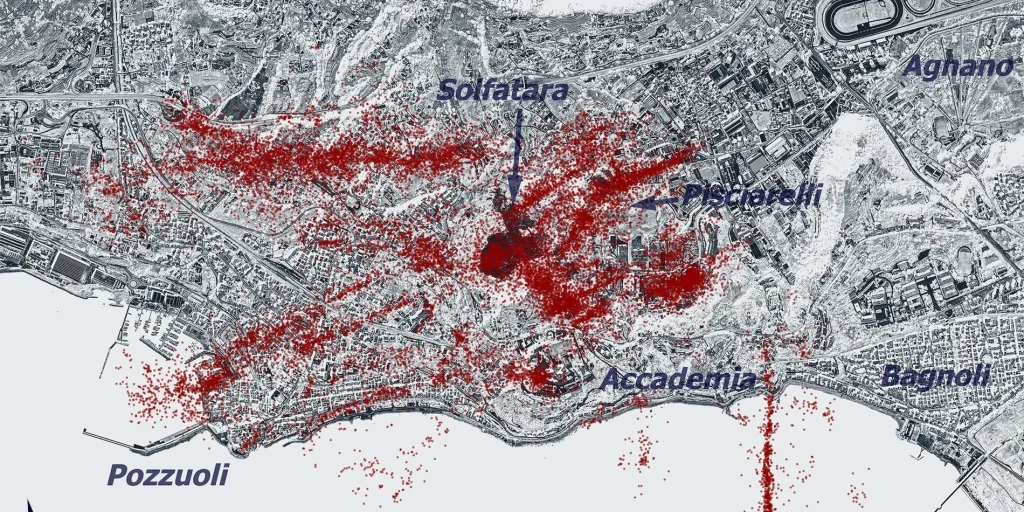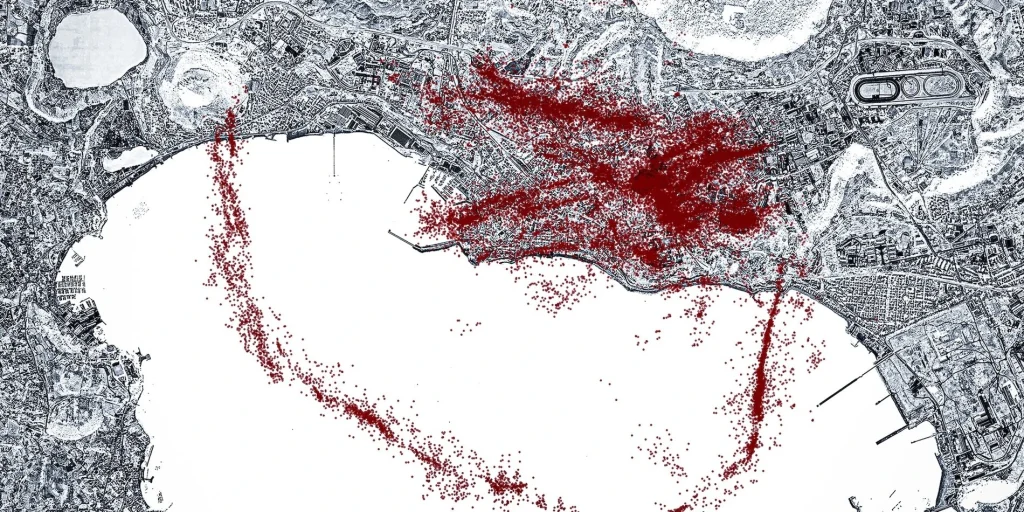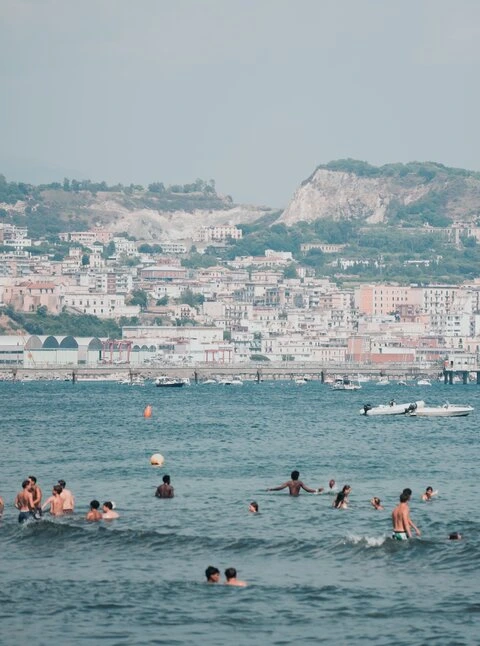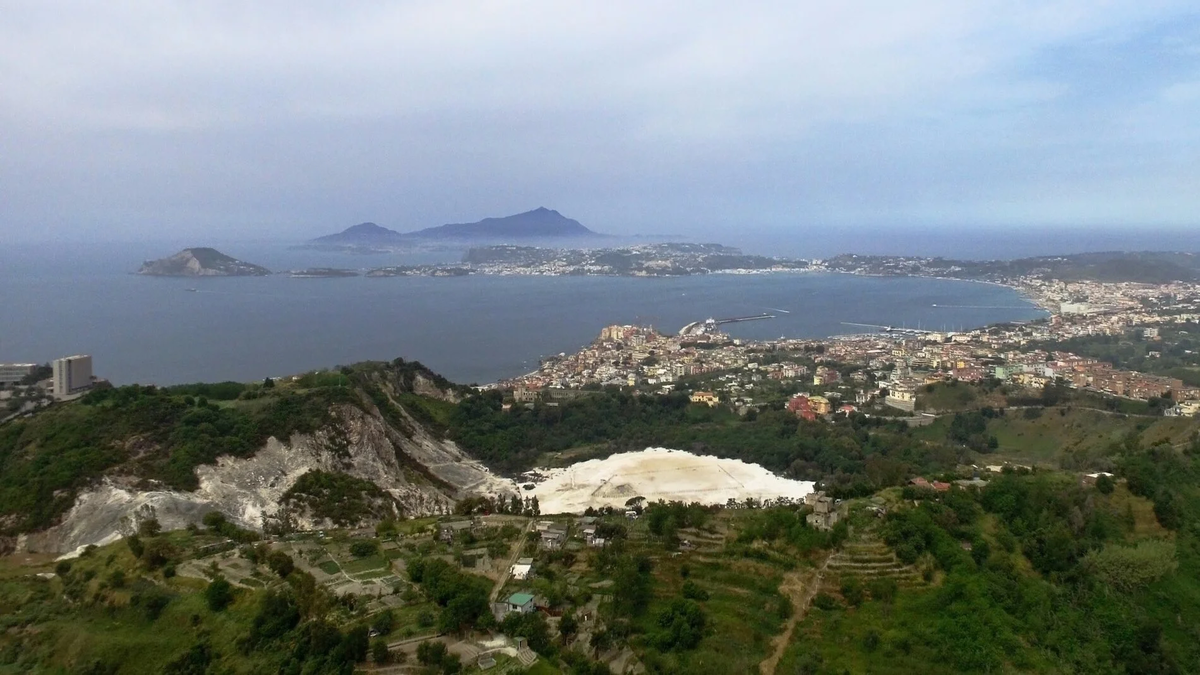A powerful artificial intelligence model developed by Stanford University and Italy’s National Institute of Geophysics and Volcanology (INGV) has revealed a sharply defined ring-fault system beneath the Campi Flegrei volcanic region near Naples. The discovery provides the most detailed picture ever of how stress is building beneath one of Europe’s most densely populated volcanic areas.
Researchers analyzed seismic data collected between January 21, 2022, and March 20, 2025, detecting more than 54 000 earthquakes that had escaped earlier analysis. This represents a fourfold increase over traditional methods, which had catalogued only about 12 000 events.
The machine-learning workflow can identify earthquakes in near real time, distinguishing genuine seismic signals from background noise. Italian scientists at INGV have now integrated the system into their operational monitoring network. According to the study published in Science on September 4, 2025, the approach may transform volcanic hazard monitoring across southern Europe.
Greg Beroza, a professor of geophysics at Stanford University, said that the system’s ability to reveal change almost instantly could become a critical asset for emergency response. “Seismicity could change at any time, and that may be the most important thing about this study, this capability of getting a clear view is now operational,” he explained.
 This image shows earthquakes that occurred in the Pozzuoli-Campi Flegrei region about 7 miles west of central Naples from 2022 to 2025 overlaid on Google Earth satellite imagery. Credit: Xing Tan
This image shows earthquakes that occurred in the Pozzuoli-Campi Flegrei region about 7 miles west of central Naples from 2022 to 2025 overlaid on Google Earth satellite imagery. Credit: Xing Tan
A ring of faults beneath the city of Pozzuoli
The new seismic catalog revealed a sharply defined structure beneath the Campi Flegrei caldera, forming a ring-fault system that circles the ancient volcanic depression. Two long faults intersect beneath the coastal town of Pozzuoli, about 11 km (7 miles) west of Naples. This fault geometry, scientists say, could potentially produce moderate earthquakes in the magnitude 5 range.
William Ellsworth, co-director of the Stanford Center for Induced and Triggered Seismicity, noted that the newly mapped structures clarify decades of uncertainty. “We’ve known this is a risky place for a long time, since the 1980s when part of the city was evacuated, and now we’re seeing for the first time the geologic structures that are responsible,” he said.
Pozzuoli has long been a focal point of bradyseism, the slow rising and sinking of land caused by pressure changes below the surface. During the 1980s crisis, the ground rose more than 2 m (6.5 feet), triggering over 16 000 earthquakes and forcing the evacuation of about 40 000 residents.
Today, the ground beneath Pozzuoli is rising again at an average of 10 cm (4 inches) each year. Satellite and GPS measurements confirm that the uplift is occurring within the same zone now illuminated by the new seismic detections. This pattern suggests that the caldera’s deformation and earthquake activity are tightly linked to pressure along the ring fault.
How artificial intelligence changed the view underground
For decades, seismologists have identified earthquakes by scanning seismograms and marking where ground vibrations spike. This process, known as phase picking, is time-consuming and often misses weak or overlapping signals. The AI workflow developed at Stanford changes that by learning from millions of expert-labeled examples.
Once trained, the system can detect and locate small earthquakes automatically. It not only identifies events too faint for human analysts but also measures their depth and magnitude with greater precision. By analyzing the timing between seismic waves, the model reconstructs a continuous picture of fault movement inside the volcano.
Beroza explained that before this project, seismicity within the Campi Flegrei caldera appeared scattered and indistinct. Now, a thin, well-defined ring of earthquakes matches the visible surface fractures and areas of uplift observed by satellites. This clarity allows researchers to map where stress is accumulating, helping to anticipate which parts of the caldera might fail next.
Lead author Xing Tan, a doctoral student at Stanford, said that Italian researchers were astonished by how clearly the ring appeared in the AI data. They had expected activity mainly in the south, where older instruments had found scattered tremors, but the model showed concentrated seismicity in the north that had never been documented before.
 A distinct structure of seismicity can be seen based on earthquakes that occurred in the whole Campi Flegrei caldera about 7 miles west of central Naples from 2022 to 2025. The data is overlaid on Google Earth satellite imagery. Credit: Xing Tan
A distinct structure of seismicity can be seen based on earthquakes that occurred in the whole Campi Flegrei caldera about 7 miles west of central Naples from 2022 to 2025. The data is overlaid on Google Earth satellite imagery. Credit: Xing Tan
Pressure builds, but magma remains deep below
Despite the dramatic increase in detected earthquakes, scientists emphasize that there is no evidence of magma moving toward the surface. All seismic activity occurs at depths shallower than about 3.7 km(2.3 miles). Instead, the earthquakes appear to result from pressure in the hydrothermal system, where hot fluids and gases circulate through fractured rock.
“The study suggests that overall inflation of the caldera is driven by pressure within the hydrothermal system,” the authors wrote. As pressure builds, the crust responds by cracking along existing faults, producing bursts of small earthquakes that sometimes cluster into swarms.
This mechanism explains why the region experiences alternating phases of uplift and subsidence without eruption. The ongoing uplift of Pozzuoli and the adjacent caldera rim mirrors the zones where the new seismic catalog shows the most concentrated activity.
Although magma has not been detected rising, the new model shows that the crust is under stress. According to the research team, this means a moderate earthquake of about magnitude 5 cannot be ruled out. Such an event at shallow depth could cause serious local damage even without a volcanic eruption.
A restless landscape shaped by history
Campi Flegrei, which means “burning fields” in Italian, is a 13 km (8 miles) wide volcanic depression that formed through two colossal eruptions about 39 000 and 15 000 years ago. These eruptions, known as the Campanian Ignimbrite and Neapolitan Yellow Tuff, were among the largest in Europe’s history.
The caldera lies within the Neapolitan urban area, where more than 360 000 people live inside its boundaries and around 1.5 million inhabit the surrounding region. This population concentration makes the site one of the most dangerous volcanic systems on Earth.
Scientists have documented cycles of unrest at Campi Flegrei since the 1950s. The most recent phase began in 2005 and intensified after 2018, culminating in five earthquakes above magnitude 4 during the first eight months of 2025. The AI catalog now shows that these larger quakes are only part of a continuous swarm of smaller events.
Maps produced from the model also reveal that seismicity has accelerated since August 2023 along several shallow lineaments that cut beneath residential areas. The pattern corresponds closely to the ring-fault system seen in the new data, confirming that the unrest is structural rather than random.
 People swimming near Baia beach, Pozzuoli in Campi Flegrei, Italy. The Solfatara crater and fumarolic field are in the background. Credit: Xing Tan
People swimming near Baia beach, Pozzuoli in Campi Flegrei, Italy. The Solfatara crater and fumarolic field are in the background. Credit: Xing Tan
Lessons for other restless volcanoes
The results from Campi Flegrei demonstrate how machine learning can transform how scientists monitor active volcanic regions. The system can be adapted for other calderas with dense seismic networks, such as Santorini in Greece or Rabaul in Papua New Guinea.
By automatically identifying and locating earthquakes as they happen, the technology shortens the time between detection and interpretation. This can make the difference between timely evacuation planning and a delayed reaction when seismic crises escalate.
The researchers emphasize that their goal is not prediction but understanding. By mapping how faults interact and how pressure redistributes through the crust, scientists can refine models of volcanic behavior. The clarity achieved at Campi Flegrei marks a step toward that goal, providing data that can inform urban planning and hazard mitigation for years to come.
Ellsworth summarized the significance succinctly: “We’re seeing, for the first time, the geologic structures that are responsible.”
Why this discovery matters
The Campi Flegrei study shows how artificial intelligence can reveal order in what once seemed chaotic. By uncovering tens of thousands of hidden earthquakes and mapping the caldera’s ring-fault system, researchers have identified the pathways through which stress builds and releases beneath Naples.
This understanding changes how authorities assess risk. Instead of focusing solely on the potential for eruption, planners can now account for the threat of moderate, shallow earthquakes that could damage infrastructure without warning.
The findings also highlight the role of hydrothermal systems in shaping volcanic unrest. Even without magma intrusion, gas and fluid pressure can deform the crust, trigger swarms of earthquakes, and displace thousands of people.
With INGV now operating the AI tool independently, the region has gained a powerful new way to monitor one of Europe’s most complex natural systems. The technology’s success suggests that artificial intelligence may become a cornerstone of future volcano surveillance worldwide.
References:
1 A clearer view of the current phase of unrest at Campi Flegrei caldera – Xing Tan et al. – Science – September 4, 2025 – DOI: 10.1126/science.adw9038
2 AI model reveals hidden earthquake swarms and faults in Italy’s Campi Flegrei – Stanford – September 4, 2025

